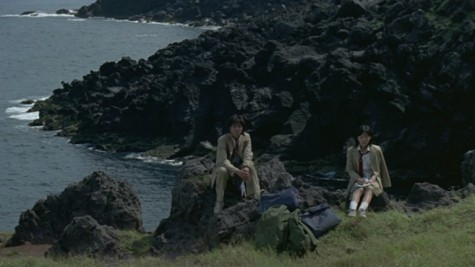Movie Monday with Luke: “Battle Royale” a B-movie thriving on concept
November 2, 2015
Can you name a film from Japan that isn’t animated? Probably. And it’s probably 2000’s “Battle Royale,” the late Kinji Fukasaku’s bloody thriller based on a novel of the same name by Koushun Takami. Celebrated for its unique, gripping concept of teenagers fighting each other for survival, the film has received another burst of popularity now that the concept isn’t so unique anymore. “The Hunger Games” series has become one of the most popular franchises in the west, and people can’t help but look to its obvious inspiration for more morbid fun. Unfortunately, they encounter the same pitfalls.
“Battle Royale” follows Shuya Nanahara (Tatsuya Fujiwara) and Noriko Nakagawa (Aki Maeda), two well-mannered kids in a sea of delinquents. In an attempt to diminish the delinquency issue, the government runs an annual event called Battle Royale, wherein a class of bad students is chosen to be sent to an island to kill each other off until there is only one left.
Shuya and Noriko’s class of 42 students is ‘randomly’ chosen with the authority of the class’s former teacher, Kitano (Takeshi Kitano), who quit after he was stabbed by a student. Shuya and Noriko team up to survive without killing anyone, although their new friend Shogo Kawada (Taro Yamamoto), a ‘transfer student’ selected specifically from outside of the class to participate, has harsher methods. He fights to protect them from Kazuo Kiriyama (Masanobu Ando), a mute and brutal ‘transfer student’ who quickly takes over the game.
Every one of the 42 students has a face and a name, but a good two-thirds don’t have anything else. The focus is always with Shuya. He, Noriko and his friend Nobu, are the only characters given any screen time whatsoever before the film’s titular event begins. Shuya exists to be nothing but the clear protagonist, lacking relevance to the overall plot despite hogging the camera. In terms of relevance, Noriko has her history with Kitano (appropriately not elaborated upon until late in the film) and Kawada has his history with the Royale as a whole. Shuya only has his innocence, which Noriko has as well. Neither truly lose it.
That may seem like a spoiler, but if you expect this movie to turn out any different than it looks like it will in the first fifteen minutes, you probably have some excess faith from skipping “The Hunger Games.” The ending is nothing short of a cop-out, rendering any tension moot, except there is practically no tension since it’s so obvious things will turn out that way. Hopefully, the mere sight of gore can hold your interest well.

This type of story really lends itself to not having a clear protagonist, and the story would be massively more engaging if Shuya were simply removed from the story. The hole left by him would be easy to fill: Kawada could be Noriko’s love interest. Kitano and his stabbing could be the focus of the prologue and flashbacks, eschewing the issue of the foregone conclusion.
If a movie all about whittling down characters one by one needs a face, who better to fill the role than the ultimate ‘killer?’
There is one scene during which I actually believed in the film beyond my initial perception: The scene in which Kitano briefs the class about the game sees the brutal death of a character who seemed like a major one, as well as a minor one. It sends the message that anyone can die, especially around a pissed Kitano, whose presence raises the tension through the roof.
Sadly, this is the only scene wherein such a tension exists, because it quickly becomes clear that message isn’t true. Shuya and Noriko can’t die. Kiriyama and side-villain Mitsuko can’t win, but also can’t die until the end. Guess what? Those are four out of about eight characters who are given any backstory or development whatsoever. Therein lies the problem with following a classical story structure with a unique, unconventional concept: It has to break the boundaries to do its concept justice, and it doesn’t.
This might read more like a review of the book than the movie. Indeed, the movie is actually too good for the story it covers. The changes the movie makes from the source material shine straight through the faithful parts. For example, the entire character of Kitano was devised for the film. In the book, his role was filled by a generic, cackling bad guy with no motivation other than enjoying evil. There was clearly an opportunity for something more, and the film ran with it, hiring one of the most famous men in Japan to breathe life into the character: “Beat” Takeshi Kitano, renowned director, actor, writer and comedian (and FYI, every one of his own films is far and away better than this one).
Kitano plays the character of the same name as a human rather than a monster. He’s tired, hurt and simply trying to snuff out something that makes him happy in a world that’s been nothing but cruel to him: Not killing, no… Something else. In fact, killing is hardly anything to him. If he’s sick of someone’s whining, then boom, knife to the head. There’s little more intimidating than a villain who does his dirty deeds not with a laugh, but with a groan. He’s intelligent and experienced with motives beyond shallow justification for the plot.
The film’s other villain, Kiriyama, is also heavily altered from the source material. In the book, he was a smooth-talker who supposedly lacked the ability to feel. Yeah, right. Check my “Equilibrium” review for my feelings on that. The film turns him into a mute. Mixed with his determination as the game’s most active competitor, he comes off as a believable sort of freak. Ando’s performance is particularly impressive because he shows so much drive without speaking. His occasional grins always mean bad news, and he walks in a casual, cool-guy manner, as though killing has been his entire life. He contrasts Kitano perfectly, and together they cover all the bases: The reason for the plot and the immediate threat. With these awesome changes, it’s a shame the film is as faithful as it is…
Kiriyama’s killing scenes are appropriately terrifying, and the film tries to flaunt a few creative deaths. The most notable is a chain reaction late in the film, lending the students caught inside ‘one-scene wonder’ status. The gore is rather unconvincing, often taking the form of CG splashes that look like they were copied and pasted from a $20 special effects program, so don’t worry too much if you’re squeamish.
SHOULD YOU WATCH IT? “Battle Royale” is, for all intents and purposes, a B-movie that made it big based solely on its concept. Watching it only enforces disappointment in the fact that no one’s ever made a big teenage ‘battle royale to the death’ film without copping-out or cashing-in. The standout performances of Kitano and Ando will definitely stick with you, though.
WATCH IF YOU LIKE: Sion Sono’s over-the-top horror-mystery “Suicide Club” from 2001.


